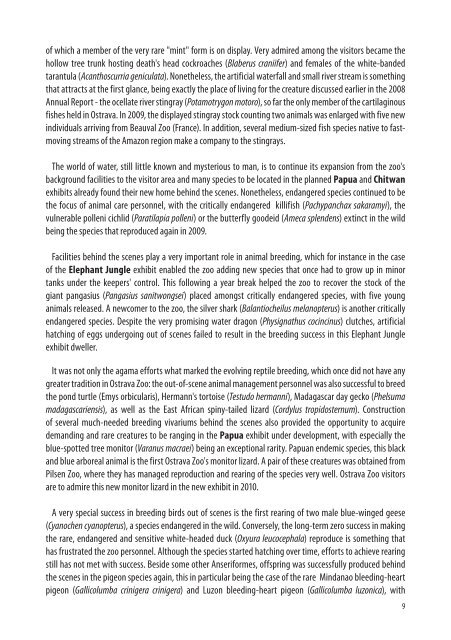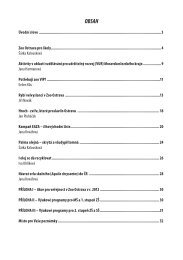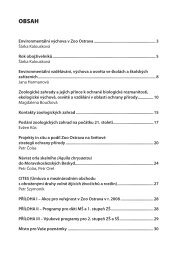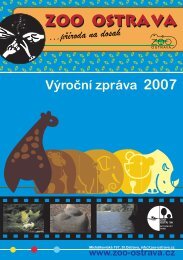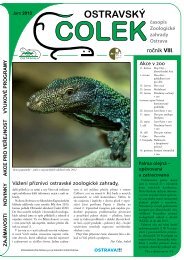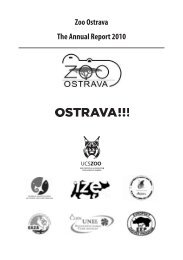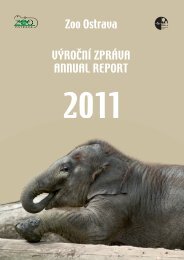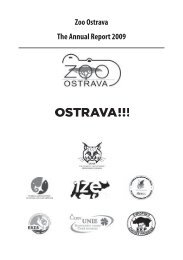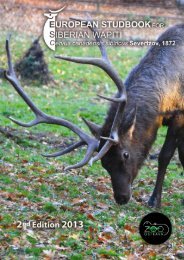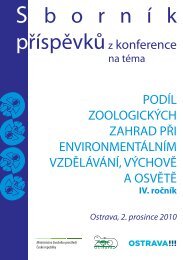the new breeding male Calvin coming from Hannover <strong>Zoo</strong> to the elephant group possible. The process ofuniting the females and the male went very well and mating already occurred as well, with both Belfastfemales mating with the male in turn. In the late <strong>2009</strong>, both females were confirmed pregnant. The elephantmanagement is discussed in more detail under a separate paper in this annual report (page 62).At the African Animal House, the offspring of the southern ground hornbill (Bucorvus leadbeateri) wasproduced for a third year in a row. Nonetheless, the year <strong>2009</strong> was the more successful as the zoo managed torear both chicks hatched. More details can be found on page 60. In addition, natural rearing was underway inAfrican ostriches (Struthio camelus), with all of the six young successfully reared. On the other hand, the eland(Tragelaphus oryx) did not do well - the breeding male and two females died of heart disorder and trauma,respectively.The zoo also recorded a number of offspring in hoofed animals elsewhere around the area - three youngSiberian red deer (Cervus canadensis sibiricus), three Pere David’s deer (Elaphurus davidianus), four Vietnamesesika deer (Cervus nippon pseudaxis) and seven individuals of domestic llama forms - three llamas (Lamaguanicoe f. glama) and four alpacas (Lama guanicoe f. pacos). The death of the old female hippo (Hippopotamusamphibius) Roza was a great loss - read more on hippos in the article on page 65.In the primate section, several important developments were registered, with the birth and first successfulrearing of a male Sclater's lemur (Eulemur macaco flavifrons) being certainly the greatest success. The younganimal was one of a mere three more young Sclater's lemurs in Europe in <strong>2009</strong>. Some time later, this successwas stigmatised by the death of the breeding male due to bone tumour of the animal's spine. Subsequently,the zoo imported a pair of this lemur species from Poznan <strong>Zoo</strong> at the end of the year. Read more about theSclater's lemur on page 44. Aside from the lemurs above, the zoo reared a third young red-bellied lemur(Eulemur rubriventer) in a row. The ring-tailed lemur (Lemur catta) was another species with traditionalbreeding success, with a female born and reared.For visitors, the birth of a chimpanzee female (Pan troglodytes) must have been the top event. This was thefirst baby chimp born following a nine-year break. A third young chimpanzee born in the recent period, it wasthe first descendant of the male Sebastian, who arrived from Krakow <strong>Zoo</strong> a year earlier. Read more on page46. In addition to the reared animals mentioned above, offspring was produced in the species that breedroutinely: the Hanuman langur (Semnopithecus entellus) and Diana monkey (Cercopithecus diana diana), withsex of the two animals still unknown. A new breeding male arriving from Lisbon was successfully integratedinto the group of lion-tailed macaques (Macaca silenus).In the first half of the year, a group of cotton-top tamarins (Saguinus oedipus) was imported for the newLittle Amazonia exhibit from Dresden <strong>Zoo</strong>, and enlarged very early with two new individuals - youngtamarins born a month after arrival; see separate report on page 43. The new exhibit was also the placeof introduction for many other animals, especially some lesser species. The vivarium imitating the primaryforest habitat became a new home for frogs, more specifically, two poison dart frogs - colour, but fearedand poisonous members of the Amazon Basin fauna. The three-striped poison frog (Ameerega trivittata) isthe more common of the two; black and green in colour, it is not easy to detect in the vegetation. Criticallyendangered, the golden poison frog (Phyllobates terribilis) is found in the wild in three different colour tones,8
of which a member of the very rare "mint" form is on display. Very admired among the visitors became thehollow tree trunk hosting death's head cockroaches (Blaberus craniifer) and females of the white-bandedtarantula (Acanthoscurria geniculata). Nonetheless, the artificial waterfall and small river stream is somethingthat attracts at the first glance, being exactly the place of living for the creature discussed earlier in the 2008Annual Report - the ocellate river stingray (Potamotrygon motoro), so far the only member of the cartilaginousfishes held in <strong>Ostrava</strong>. In <strong>2009</strong>, the displayed stingray stock counting two animals was enlarged with five newindividuals arriving from Beauval <strong>Zoo</strong> (France). In addition, several medium-sized fish species native to fastmovingstreams of the Amazon region make a company to the stingrays.The world of water, still little known and mysterious to man, is to continue its expansion from the zoo'sbackground facilities to the visitor area and many species to be located in the planned Papua and Chitwanexhibits already found their new home behind the scenes. Nonetheless, endangered species continued to bethe focus of animal care personnel, with the critically endangered killifish (Pachypanchax sakaramyi), thevulnerable polleni cichlid (Paratilapia polleni) or the butterfly goodeid (Ameca splendens) extinct in the wildbeing the species that reproduced again in <strong>2009</strong>.Facilities behind the scenes play a very important role in animal breeding, which for instance in the caseof the Elephant Jungle exhibit enabled the zoo adding new species that once had to grow up in minortanks under the keepers' control. This following a year break helped the zoo to recover the stock of thegiant pangasius (Pangasius sanitwongsei) placed amongst critically endangered species, with five younganimals released. A newcomer to the zoo, the silver shark (Balantiocheilus melanopterus) is another criticallyendangered species. Despite the very promising water dragon (Physignathus cocincinus) clutches, artificialhatching of eggs undergoing out of scenes failed to result in the breeding success in this Elephant Jungleexhibit dweller.It was not only the agama efforts what marked the evolving reptile breeding, which once did not have anygreater tradition in <strong>Ostrava</strong> <strong>Zoo</strong>: the out-of-scene animal management personnel was also successful to breedthe pond turtle (Emys orbicularis), Hermann's tortoise (Testudo hermanni), Madagascar day gecko (Phelsumamadagascariensis), as well as the East African spiny-tailed lizard (Cordylus tropidosternum). Constructionof several much-needed breeding vivariums behind the scenes also provided the opportunity to acquiredemanding and rare creatures to be ranging in the Papua exhibit under development, with especially theblue-spotted tree monitor (Varanus macraei) being an exceptional rarity. Papuan endemic species, this blackand blue arboreal animal is the first <strong>Ostrava</strong> <strong>Zoo</strong>'s monitor lizard. A pair of these creatures was obtained fromPilsen <strong>Zoo</strong>, where they has managed reproduction and rearing of the species very well. <strong>Ostrava</strong> <strong>Zoo</strong> visitorsare to admire this new monitor lizard in the new exhibit in 2010.A very special success in breeding birds out of scenes is the first rearing of two male blue-winged geese(Cyanochen cyanopterus), a species endangered in the wild. Conversely, the long-term zero success in makingthe rare, endangered and sensitive white-headed duck (Oxyura leucocephala) reproduce is something thathas frustrated the zoo personnel. Although the species started hatching over time, efforts to achieve rearingstill has not met with success. Beside some other Anseriformes, offspring was successfully produced behindthe scenes in the pigeon species again, this in particular being the case of the rare Mindanao bleeding-heartpigeon (Gallicolumba crinigera crinigera) and Luzon bleeding-heart pigeon (Gallicolumba luzonica), with9
- Page 2 and 3:
Provozovatel zoo: Zoologická zahra
- Page 5 and 6:
ObsahÚvodní slovo ředitelePetr
- Page 7 and 8:
Vážení příznivci Zoo Ostrava,d
- Page 9 and 10:
Stavy chovaných zvířatChov zví
- Page 12 and 13:
pečovaly o mláďata z roku předc
- Page 15 and 16:
2) z účelově vázaného přísp
- Page 17 and 18:
Rok 2009 byl pro naši organizaci v
- Page 19 and 20:
Výnosy v roce 2009v tis.Kč% změn
- Page 21 and 22:
Osobní náklady tj. vlastní mzdy,
- Page 23 and 24:
Výstavba, projektová činnost a
- Page 25 and 26:
Z dalších změn v areálu zoo sto
- Page 27 and 28:
• byla dokončena projektová př
- Page 29 and 30:
Vzdělávací a propagační činno
- Page 31 and 32:
• 25.7. Když si zvířata hrají
- Page 33 and 34:
Činnost dendrologického oddělen
- Page 35 and 36:
Pozorování a sběr údajů o zví
- Page 37 and 38:
Rok šelem v Zoo OstravaMonika Ondr
- Page 39 and 40:
Historický nárůst počtu chovan
- Page 41 and 42:
Chov nového druhu primáta v Zoo O
- Page 43 and 44:
akovinným bujením, které zapří
- Page 45 and 46:
Odchov supa hnědého v Zoo Ostrava
- Page 47 and 48:
Repatriace supa hnědého a orlosup
- Page 49 and 50:
ještě před vylétnutím a jejich
- Page 51 and 52:
Odchov ohrožených druhů papoušk
- Page 53 and 54:
tuto budku přijali. Opět si vytvo
- Page 55 and 56:
pobývali většinou venku, mládě
- Page 57 and 58:
Novinky u slonůPavel ZvolánekRok
- Page 59 and 60:
při průchodu porodními cestami,
- Page 61 and 62:
Róze se poslední mládě narodilo
- Page 63 and 64:
Návrat orla skalního (Aquila chry
- Page 65 and 66: Seznam zaměstnanců Zoo Ostrava (k
- Page 67 and 68: Jméno Funkce Počet let v org.62 P
- Page 69 and 70: Druh (poddruh)Species (subspecies)S
- Page 71 and 72: Druh (poddruh)Species (subspecies)S
- Page 73 and 74: Druh (poddruh)Species (subspecies)S
- Page 75 and 76: Druh (poddruh)Species (subspecies)S
- Page 77 and 78: Druh (poddruh)Species (subspecies)S
- Page 79 and 80: Druh (poddruh)Species (subspecies)S
- Page 81 and 82: Druh (poddruh)Species (subspecies)S
- Page 83 and 84: Druh (poddruh)Species (subspecies)S
- Page 85 and 86: Druh (poddruh)Species (subspecies)S
- Page 87 and 88: Druh (poddruh)Species (subspecies)S
- Page 89 and 90: Druh (poddruh)Species (subspecies)S
- Page 91 and 92: Druh (poddruh)Species (subspecies)M
- Page 93 and 94: FormaFormazajícovci (Lagomorpha)St
- Page 95 and 96: ▲ Nejvzácnější přírůstek r
- Page 97 and 98: ▲ Úprava vnitřních prostor v p
- Page 99 and 100: ▲ Odběr spermatu u samce slona i
- Page 101 and 102: ◀ Nový druh v Zoo Ostrava - peli
- Page 103 and 104: ▶ Pohlednice u voliéry supů hn
- Page 105 and 106: ◀ Google v zoo při sběru datpro
- Page 108 and 109: Zoological Garden OstravaAddress: Z
- Page 111 and 112: ContentsDirector´s introductory wo
- Page 113 and 114: Dear friends,Ostrava Zoo is coming
- Page 115: Animal numbersAnimal collection in
- Page 119 and 120: success refers to the offspring pro
- Page 121 and 122: The founder’s non-capital funding
- Page 123 and 124: 3) CZK 737 thousand allocated to re
- Page 125 and 126: To co-fund 46.4% from the operating
- Page 127 and 128: As regards cost items in 2009, only
- Page 129 and 130: namely tiger enclosures, hoofed mam
- Page 131 and 132: Design, development and maintenance
- Page 133 and 134: This operation was supported by the
- Page 135 and 136: • Development of the building app
- Page 137 and 138: Ostrava Zoo - the zoo office and ma
- Page 139 and 140: Again, the event was co-funded by t
- Page 141 and 142: and involved models of a turtle she
- Page 143 and 144: Activities of the Horticulture Depa
- Page 145 and 146: and it was carried out by the scien
- Page 147 and 148: A year of carnivores at Ostrava Zoo
- Page 149 and 150: Historical increase in the number o
- Page 151 and 152: Keeping a new primate species at Os
- Page 153 and 154: for the lemurs, where the family of
- Page 155 and 156: Month 8 Beira's climbing the ropes
- Page 157 and 158: as the birds changed over on 28 Apr
- Page 159 and 160: • Birds of prey are rather slow i
- Page 161 and 162: Monitoring nests of endangered bird
- Page 163 and 164: The yellow cardinal at Ostrava ZooY
- Page 165 and 166: a bowl with fresh water multiple ti
- Page 167 and 168:
it was found that one egg was impre
- Page 169 and 170:
eginnings when the young are fed by
- Page 171 and 172:
The way the bull was handled within
- Page 173 and 174:
Keeping the common hippopotamus (Hi
- Page 175 and 176:
Studbook # /nameSexDate ofbirthDam/
- Page 177 and 178:
General summaryThanks to the projec
- Page 179 and 180:
NamePositionNumber of yearsin the o


